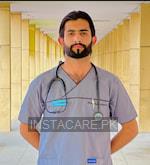Perthes Disease - Symptoms, Risk factors and Treatment
Last Updated On Saturday, December 20, 2025
Perthes Disease in Urdu
Perthes بیماری یا Legg-Calve-Perthes بیماری بچپن کی ایک ایسی حالت ہے جو کولہے کے جوڑ کو متاثر کرتی ہے۔ یہ اس وقت ہوتا ہے جب ران کی ہڈی (فیمر) کے کسی حصے میں خون کی فراہمی میں خلل پڑتا ہے۔
ہپ جوائنٹ کیسے کام کرتا ہے؟
ہپ جوائنٹ جسم میں 'بال اور ساکٹ' جوڑ کی ایک قسم ہے۔ کولہے کا جوڑ دو ہڈیوں پر مشتمل ہوتا ہے، فیمر (ران کی ہڈی) اور کولہے کی ہڈی، اور فیمر میں ایک بڑا، گول حصہ ہوتا ہے جسے سر کے نام سے جانا جاتا ہے، جو اپنے آپ کو کولہے کی ہڈی کے ساکٹ میں جوڑتا ہے، "گیند" کے طور پر حصہ لیتا ہے۔ جوڑ بنانے کے لیے ساکٹ (ہپ کی ہڈی) کا۔ مل کر، فیمر اور کولہے کی ہڈی کے ساتھ ساتھ مختلف عضلات اور لیگامینٹس، کولہے کا جوڑ بناتے ہیں۔ فیمر کا گول سر کولہے کے جوڑ کو وسیع پیمانے پر حرکت کرنے کی اجازت دیتا ہے، جس کی وجہ سے ٹانگ کو متعدد سمتوں میں منتقل کیا جا سکتا ہے۔
Perthes Disease in English
Perthes disease or Legg-Calve-Perthes disease is a condition of childhood that affects the hip joint. It occurs when the blood supply to a part of the thigh bone (femur) is disrupted.
How does the hip joint work?
The hip joint is a type of ‘ball and socket' joint in the body. The hip joint consists of two bones, the femur (thigh bone) and the hip bone, and the femur contain a big, rounded part known as the head, which attaches itself in the socket of the hip bone, participating as the “ball” of the socket (hip bone) to form the joint. Together, the femur and the hip bone along with various muscles and ligaments, form the hip joint. The rounded head of the femur allows the hip joint to perform a wide range of motion, due to which the leg can be moved in multiple directions.
What causes Perthes disease?
The exact cause of Perthes disease is unknown. Perthes disease is a series of stages that ultimately results in the collapse of the head of the femur. The different stages in Perthes disease include:
Death of bone cells (Avascular necrosis): In this stage, the blood supply to the femoral head is disrupted, and the bone cells of that area begin to die, a process known as necrosis.
Replacement of dead cells with new bone (Fragmentation): In this stage, the body removes the dead cells and replaces them with new bone. The new bone is soft and weak during this stage, the head of the femur is vulnerable to shape deformity and flattening.
Development of stronger bone (Reossification): In this stage, the weak bone cells are ossified and a new, stronger bone is formed.
Healing of bone: This is the final stage. In this stage, the bone starts to heal, and complete recovery starts. The shape of the new bone formed may be round or may be flat, depending on different factors such as the extent of damage to the bone.
Symptoms of Perthes disease:
The condition may represent different signs and symptoms such as:
Abnormal gait: Damage to the hip joint affects the way your child walks normally (gait). Your child may limp and may be unable to properly move the leg in all directions. Abnormal gait may become evident in different activities such as running.
Other than abnormal gait, your child may complain about:
- Pain in the hip, groin, thigh, or knee
- Stiffness in the hip, groin thigh, or knee
- Pain that worsens after physical activity
Diagnosis of Perthes disease:
Perthes disease can be diagnosed by a doctor by physical exams and different imaging tests. During a physical exam, the doctor may assess the range of motion of the hip joint. For imaging, the doctor may suggest an X-ray, MRI, CT scan to diagnose Perthes disease.
Treatment of Perthes disease:
The treatment of Perthes disease varies depending upon different factors such as the age of the child, the extent of deformity, etc. For very young children, the treatment may be aimed at simple observation. Regular x-rays can be obtained, and the development of the femoral head can be monitored closely. The femoral head may develop normally by itself. If the disease requires intervention, the following strategies may be used:
- Painkiller medications to reduce pain
- Avoiding excessive physical activity and lifting weights
- Physical therapy
- Casts and braces
- Using crutches for walking
- Surgery to correct the shape of the femoral head
Conclusion:
Perthes disease is a condition of childhood affecting the hip joint. With appropriate treatment on time, the prognosis is good, and children can completely recover. However, if not treated properly, the head of the femur may not be properly shaped and not fit into the hip joint, causing permanent deformity. If you notice any change in your child’s gait, it is recommended to consult your doctor.









